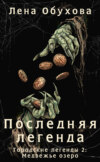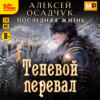Read the book: «Russia the formation of the state in the 9th century Veneds and the severjans (northerners), part of the Huns, which became the basis of a new community»
© Sergey Solovyov, 2020
ISBN 978-5-0051-5935-9
Created with Ridero smart publishing system
Foreword
This study aims to pose new questions and provide unambiguous answers in the history of the creation of the Old Russian state in the 9th century AD. This topic has always been important, because it touches the very foundation of our country, Russia, because Russia was and is the forerunner of the Russian Federation, a huge state stretching from the sources of the Dnieper, the shores of the Baltic and the Sea of Azov, Crimea and to the shores of the Pacific Ocean. Many peoples found themselves in the orbit and borders of our state, and the rights, freedoms and language of these peoples are protected by the Constitution of Russia. So a will of chance or a historical pattern was the reason for the creation of such a large and multinational country? The author will try to substantively prove that it was a natural historical process that was the reason, and not an accident or the good or evil will of several rulers. Did associations of peoples exist before the 9th century on this territory? Yes, undoubtedly, and, moreover, from time immemorial. There were attempts to find the homeland of the Slavs in the Pripyat swamps, in fact, it is not clear where and it is not clear from where. Trying to juggle more with the fact that the very name “Slovenes” or “Slavs” appears only in the 6th century AD. from Procopius of Cessaria. Yes, this is exactly the case, but there is another amendment, or clarification. In Germany, where undoubted Slavs live, the original population of these lands, the Lusatian Serbs. So, in Germany, officially the Slavs are called only SERBEN and WENDEN (Ladusch, Manfred, etc. Die Sorben in Deutschland) and no, absolutely no Slavs. So, based on the logic of these scientists, there were no Slavs on the territory of East Germany. However, this is not so and not at all so. It is on this territory since the 12th century BC. the Vendian tribes live compactly. By the way, our neighbors the Finns and the Estonians still call Russia Venaja, that is, showing the continuity from the Wends to the Russians. It was the migration of the Vendian tribes to the South and East that was described by Procopius in the 6th century, apparently the very beginning of a long process. But, it is clear that in the East, the Vendians met not an empty land, but a land inhabited by tribes directly descended from the Scythians, Sarmatians and Huns, which is one and the same, that is, the tribal union of the Northerners. But, it should be noted that Ptolemy as early as the 2nd century AD. described Sarmatia as a territory from the Oder to the Urals and further, dividing Sarmatia into European and Asian, a country with many cities. Not only Ptolemy speaks about the already formed states on the territory of present-day Russia, Poland and Germany. This is stated in the ancient High German epic “Dietrich of Berne”. Also in this context are interesting and “Vilkina-Saga” and “Ortnit”.
Geography
The very place of formation of the Slavic ethnos amazes the imagination – from the Ob River, according to “Guestrovskaya Ode” and “The Legend of Slaven and Ruse” to the Oder in the west, the Baltic Sea and the Danube. Deep rivers flow through this vast territory, which in themselves served as an obstacle to the migration of people – the Volga, Don, Dnieper, Prut, Vistula, Dvina, Danube, Elbe and Oder. As you can see, the wave of migration of the ancestors of the Slavs in ancient times was so powerful and irresistible that the tribes of the ancestors of the Slavs were able to cross these obstacles and settle over a vast territory.
This area belongs to the temperate zone, with a pronounced change in climate in winter and summer. The abundance of industrial wood made it the most common material for the craft – houses, dishes, fortified areas were built from wood, and due to the abundance of material, it was not too expensive. The downside was the frequent fires that destroyed buildings. Also, monuments and buildings made of wood are poorly preserved in the ground, often leaving only ramparts and ditches that have drifted from time to time. However, recently, researchers have learned to apply the analysis of images from space or resort to the help of aviation.
The abundance of water sources has always helped agriculture, and farming and cattle breeding. Harvests, at that distant time, of course, were not as plentiful as in Mesopotamia and Egypt. It rains regularly, and although there are droughts, they are not decisive, as there are no desert areas. However, excluding the Urals, these lands are relatively poor in copper deposits, which was important in ancient times, but the Baltic states had amber, which for many thousands of years became the basis of exchange. The culture of clay processing – ceramic production – was developed, and it was also very peculiar. In general, ceramics is one of the most important indicators of different cultures, making it possible to judge their similarities and differences. In the Volga-Don basin, such a source of exchange could only be grain and valuable fur raw materials obtained from the North and Siberia, as well as honey and wax. The ancestors of the Slavs also domesticated cattle, using cows, sheep, goats in the economy.
It may seem strange, but before domesticating horses on the farm, especially in the Northern regions, moose were used as a draft force. From agricultural products, cereals are known, cabbage, beets and carrots early came into the life of the ancestors of the Slavs, like apples. Judging by the references in the songs, grapes were also grown. Fishing was also an important craft, often replacing and supplementing bread in case of crop failures, and consequently, shipbuilding developed, which was so original that it is difficult to believe now – the boats were not knocked down by nails, but were sewn together by attaching boards to the ship’s frame. Even earlier vessels were leather, with a skin made of animal skin.
Sources
Mythology
The first, although not the most important, source of information about such a distant past is myths and fairy tales. Though not simple, but fruitful work, myths and legends reveal their secrets to researchers, like the well-known example of the great Heinrich Schliemann and Arthur Evans, who revealed the mysterious depths of the then unknown Cretan-Mycenaean culture, based on the poems of Homer and ancient Greek myths.
Fairy tales
Bear-father
These are the tales “Three Bears” and “Masha and the Bear”. Both tales are based on the myth of the ancestor bear. In the first, “Three Bears”, the girl gets into the house of bears in the forest, trying their food, and trying to sleep, and then runs away.
In the fairy tale “Masha and the Bear”, the girl Masha gets into the bear’s house, and remains to live with him. Then, the girl Masha is tricked back into her house, asking the Bear to bring gifts to grandfather and grandmother. And she climbs into the box. It is obvious that many fairy tales, such as “Beauty and the Beast”, “The Scarlet Flower” are based on this particular tale. Where, Monster Bear, then brings the girl home. Here, again, there is a tale about the First Ancestor-Bear, who returns (GIVES from the dead) a girl, and returns her to the world of people.
The bear, generally a revered animal among the Slavs, is an object of cult and respect.
Swan geese
The cult animal, along with the bear, was the swan goose, which are inseparably mentioned in the tales of the Russian people. However, similar, even more likely, identical legends are observed in Pomerania and Denmark and Sweden, where the Huns-Hans reached in the Bronze Age. The very name of this tribe is associated with the goose, because in German it is Hans-goose. And naturally, tales and legends with a goose are numerous – Geese-Swans appear in many tales. But earlier, the goose was the subject of a cult – this animal, as in the myths of Apollo, who also came from the North, carried the soul of the deceased to the Land of the Dead. This is evidenced by the numerous figurines of these birds in the burials of the Scythians, Sarmatians and Huns. But in the Bronze Age, geese were depicted schematically, in the form of a meander.
We lived with a grandmother
Two cheerful geese, —
One is gray
The other is white
Two cheerful geese.
Stretched out their necks
Who is longer —
One is gray
The other is white
Who is longer.
Washed geese paws
In a puddle by the groove, —
One is gray
The other is white
Hid in a groove
Here the granny shouts: —
Oh, the geese are gone
One is gray
The other is white
My geese, geese.
Geese came out
Bowed to the granny
One is gray
The other is white
They bowed to the grandmother.
The Sarmatians also accompanied the goose in the afterlife. Obviously, judging by the tales, he had to fly away with the soul of the deceased to the ancestral home, the distant North. In Moksha, Gus is matsi, -kht, the latter is close to the word HUNT. In German Goose is Gans. The Saks also had a swan as a sacred creature, whose function was to deliver the soul of the deceased to the afterlife. Let’s remember the team of Apollo’s swans.
The cult of the swan-goose, associated with the cult of Apollo and Artemis, also proves that the Huns-Hans in the third millennium reached Hellas. In the Russian fairy tales “Geese-Swans” Ivanushka is kidnapped, carried away to distant lands, and his sister Alyonushka (form of the name Elena) rescues him. Here, obviously, there is an overgrowth in the tale of the idea that after death the geese-swans take the soul of the deceased to the Afterlife. There are fairy tales with a similar plot in Denmark, Sweden and Germany.
Among the many living attributes of Apollo, the swan rightfully occupies the main place. The popularity of the motive “Apollo and the Swans” has been attested to throughout the whole of antiquity. This beautiful proud bird accompanies the divine twins of Apollo and Artemida “the most beautiful glorious descendants of Uranus” (Hes. Theog., 920). Sometimes on a swan (and more often on a goose, judging by the vasopis), there is a “golden Afrodite” or its fool Eros (but this is already late Hellenism).
Poets and philosophers often call the swan the bird of Apollo (H. h., XXI. 1 sq.; Sapph. Frg. 147b, Pla¬to, Phed., 85b.), “The voiceless singer of God”, “the most singing of birds” (Call. Hymn., II, 5; IV, 249), “the favorite of the muses” (Eur. Ip. Phig. T. 1103—1105), “Pythian and Delian” (Aristoph. Av., 870). “Long-necked the joy of Apollo “magnifies the swan Bacchilides (Dyph., 16). The motive of the “swan song” was not known in antiquity, it is not found in Homer, Hesiod, and also in the Homeric hymns. On the contrary, the swan in the sacred places of Apollo sings constantly, glorifying the birth of God on the Deloss (Call., II, 250—254), or before ¬sharing his appearance (II, 5; Aris¬toph. Av., 769—770), or singing hymns in the country of the Hyper- ¬shen¬no¬no¬activity¬ects. As Elian reports (De nat. An., XI, 1), at this time, clouds of swans are falling from the Ripean mountains, “they fly around the temple, as if cleansing him with her flight”, and then ceremoniously settling on the fence of the temple,” representing great in abundance and beauty. “When the singers begin to glorify God, accompanied by the kifarists, “then the swans of the message join in singing and ¬In this way, nowhere do they sing awkwardly or inaccurately, “viro-tuozy, singing the melody, like experienced singers, guided by choir- hom. And all day long “the above-named first-time singers all together glorify and rise to God.”
Epics
Russian fairy tales and epics are a whole world for inquisitive researchers and scientists. The best known to readers are the epics about Svyatogor, Ilya Muromets. Alyosha Popovich, Dobryne Nikitiche.
Svyatogor
Svyatogor, the most ancient bogatyr, a true giant, is inextricably linked with the mountains, and the earth itself carries him with difficulty. Here is a description of a titan, who has no connection with the real characters of the story, but rather in a mythological way. He carried his wife in a coffin, or a basket with him, and at the end of his life, he lays down alive in a coffin, and gives his strength to Ilya Muromets. There are no analogues of such a hero in the epics of other Slavic peoples.
Ilya Muromets
“Be you, Ilya, a great hero,
And death is not written to you in battle …”
Ilya Muromets (full epic name – Ilya Muromets son Ivanovich, there are also variants: Ilya Morovlin (Kallash: VPIM, 1889, p. 204.), Muravlenin, Murovets, Muromlyan; one of the main heroes of the Russian epic epic, a hero who embodies the common folk the ideal of a hero-warrior.According to later versions of epics, a peasant son and future defender of the Russian land from enemies, paralyzed up to 33 years old, receives strength from the elders (another option is from the Kalik pedestrians), after which he fights with the Nightingale the Robber, an idol, a Jew, Tatars and, finally, does not die, but turns to stone.
Here old Ilya built an Indian church
How did he start building the Peshterskaya Church
Tutova is old and petrified (Kirievsky, I, 86).
In a number of epics, Ilya Muromets is associated with Italy. The most interesting is a special version, recorded in 1871 on the shores of Lake Onega from an excellent connoisseur of the epic tradition Trofim Grigorievich Ryabinin. It speaks of the hero’s meeting not with his son, but with his daughter, who is looking for her father and, in response to Ilya’s questions, says that she was born in Italy, where her mother still lives. From the dialogue it turns out that Ilya lived with her mother when he helped the Italian king.
I am a native of the land and from the Talyan,
I have a dear mother, an honest widow,
Yes, honestly, she is a widow. <…>
And she let me go to go to Holy Russia
Look for a dog and my dear father <…>
Ilya, learning that this is his daughter, tells her:
“And when I was in that land in Talyanskoy,
For three years I served with the king of Talyans,
Yes I lived then yes y with an honest widow,
At the honest widow and y at the chariot <..
Our epic scholars have repeatedly noted the high artistic merits of this version. It was naturally included in the compiled by A.M. Astakhova academic anthology of epics. The geographical connection of the cited version with Italy is indisputable and its plot correlation with the role of Ilya in the monuments of the Germanic epic, also pointing to Italy, is quite obvious. Ilya Russian is mentioned in “Vilkina-Saga”, “Saga about Tidrik of Berne”, and German poems “The Legend of Dietrich of Berne”, “Ortnit”.
Alesha Popovich
Alyosha Popovich is one of the heroes who are part of the heroic trinity together with Ilya Muromets and Dobrynya Nikitich. Alyosha is not so much strong as cunning, and knows how to play the harp. The legends about the birth are similar to the legend about the birth of Volkh-Veles, the thunder roared. At once. Like Volkh-Veles, he equipped a squad, was smart beyond his years, and like Volkh-Veles, he was married to Alenushka (a variant of the name Yelenea, Volkh’s wife). So this is most likely a Christianized image of Volkh-Veles.
Volkh Vseslavovich
Volga is the son of the serpent and the princess Martha Vseslavievna. The trembling of the earth and the terrible fear of all living creatures at the minute when Volga saw the light indicate him as the personification of some elemental force.
In the garden, in the garden in green
The young princess walked and walked
Martha Vseslavievna,
She jumped from a stone to a fierce snake —
A fierce serpent is entwined
Around Chebot green morocco,
Near a silk stocking,
He hits the white quilting with his trunk. (Part of the leg from the pelvis to the knee)
And at that time the princess suffered diarrhea,
And she suffered diarrhea and gave birth to a child.
And in the sky the moon was bright,
And a mighty hero was born in Kiev,
How young Volkh Vseslavievich would be:
The earth sprouted cheese,
The Indian kingdom was shaking gloriously,
And the blue sea swayed
For the sake of the birth of the heroic
Young Volkh Vseslavievich;
Volga-Volkh-Veles grows by leaps and bounds, and soon becomes a mighty hero, possessing not only the art of fighting enemies, but also reading from books and turning around in different animals.
The epic, as you can see, tells not about a person, but about a deity. He turned his soldiers into ants, that is, like Achilles, he commanded the Myrmidons.
Veles-Volkh goes to the kingdom of Indy, conquers, conquers it, and marries Elena Azvyakovna, Elena the Beautiful. As you can see, the similarity of the legends about Achilles and Veles is obvious.
Dobrynya Nikitich
Dobrynya Nikitich, most likely, has the basis of the image of Dobrynya, a relative of Vladimir Svyatoslavovich. The epics emphasize his greatness, reason, restraint, in contrast to Alyosha Popovich and Ilya Muromets.
Danube Ivanovic
Danube Ivanovich is more reminiscent of Ilya Muromets, but with the implication that he came to serve in Kiev from foreign lands, usually from Lithuania or Poland. He, like Dobrynya Nikitich, is engaged in matchmaking, the in-law of the king’s daughter Apraksa for Vladimir. Danube himself marries Apkasy’s sister. Nastya-polyanitsa (heroic). But by chance the hero kills Nastasya, and before her death, he pulls out of the woman’s womb a miracle child – “knee-deep in silver legs, elbows in gold, braids on the head with frequent stars” (Rybn. 9). Danube throws himself on the sword and dies.
Polish epic, Leszko Popelyush
Unfortunately, the Polish epic, as such, has not reached us. Remains of retellings of individual epic legends, included in the chronicles of Anonymous Gall, Boguhval, Kadlubk, etc. In the “Great Chronicle” of the Poles, there is a legend about two brothers, sons of the legendary hero and ruler of Krak, the founder of Krakow. They fought in a duel, the eldest won, who, like his father, was called Krak.
This legend is reminiscent of the epic “The Queen of Kryakov”. It also deals with the duel of brothers, sons of the ruler, in which the elder brother, the father’s namesake, prevails. The names of the brothers in the epic are Christian, that is, later. Moreover, Luke and Peter (Luke and Moses, Luke and Matvey) Petrovichi are the general epic names of the brothers mentioned in the pair. They can appear at the heroic outpost, on the field of the Kama massacre, in the epic about their sister Alena and Alyosha Popovich, even in the epic about Vaska Buslaev.
In the West Slavic and North Russian fairy tales, the legend about a hero nicknamed Popyalov, Popyalyshka, Popelyukh, Popelvar, Popelchek has been preserved. So, the Polish hero’s name is Leszko Popelyush, the Russian one is Alyoshka Popovich. There is a certain skldstvo, especially in the description of heroes.
In the “Great Chronicle”, it is written that a certain “weaver”, the heir of the Popelyusha family, defeated Alexander the Great not by force, but by “cunning and trick”. In honor of this feat, the hero received the nickname Leshko, that is, a deceiver, a rogue. In the epics of Russia, Alyosha Popovich also often defeated his enemies with cunning.
In the epic epic, a hero is well known who conquers enemies with “cunning and trick”. His name is Alyosha – in epics more often Alyosha —Popovich. It is also important that the Polish language is the only Slavic language, besides Russian, which has retained the word “hero” (bohater, bohatyr, bohaterz) in the meaning of “hero”, a warrior with special strength and skills. The Ukrainian “rich man” is rather a later borrowing from the Russian language, the Belarusian “bagatyr”, in fact, is only consonant with the Polish and Russian words, denoting a completely different concept – a rich man, that is, one who has wealth.
Serbian hero, Doychin
Sick Doychin, or Sick Doychin, or even, as in Romanian songs, Donchile is a hero of the Serbian and Macedonian tradition, the image of a “sick hero”. Despite the specific indication of “voivode from Thessaloniki (Thessaloniki)”, he has no prototype. The plot is “wandering” in different cultures – the filthy besermians and the Black Arap city of Solun have surrounded itself, and there is no one to protect the honest people, except for the sick hero, who has been lying practically on the stove for nine years… Well, he gets up, collects weapons, a horse, says goodbye to his relatives, will beat the Araps, returns to give his dear sister… the cut out eyes of the Black Arap (Balkans, sir!) and dies… For he is sick.
The Serbian plot most of all resembles the story of Ilya Muromets. Which until the age of 33 lay on the stove, and only pedestrian kaliks revealed the hero, and then Ilya stood up for the Russian land and defended the city of Chernigov. Here the parallels with Doychin Serbsky are evident, however, the Serbian hero was ill for only nine years. Donchile Romanian is consonant with the Russian Danube Ivanovich, but even here the image of Danube Ivanovich is consonant in the deeds and accomplishment of Ilya Muromets. And I recall in this context the legend written by Alexei Maksimovich Gorky about Danko, who illuminated the way for people with his heart.










